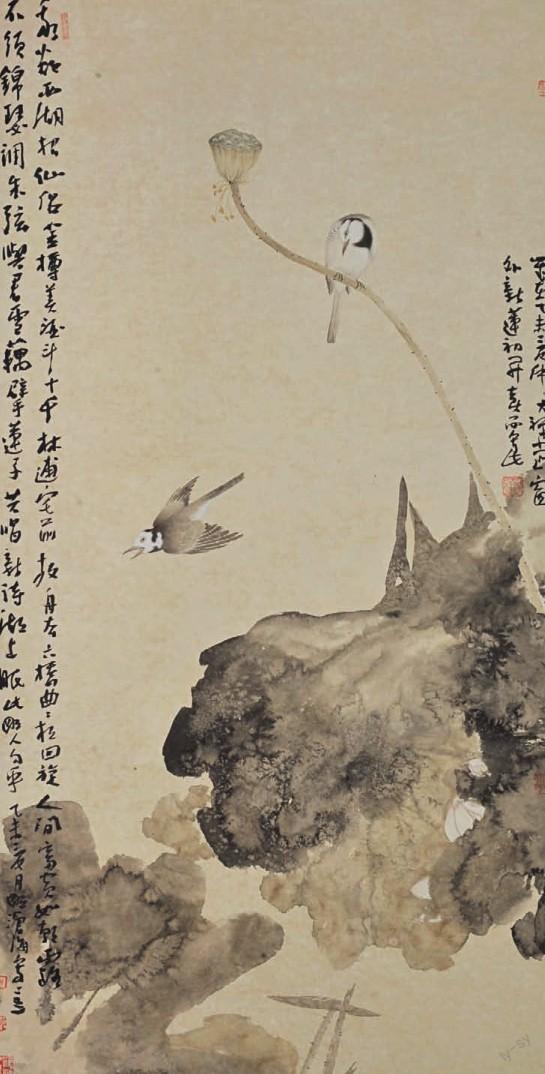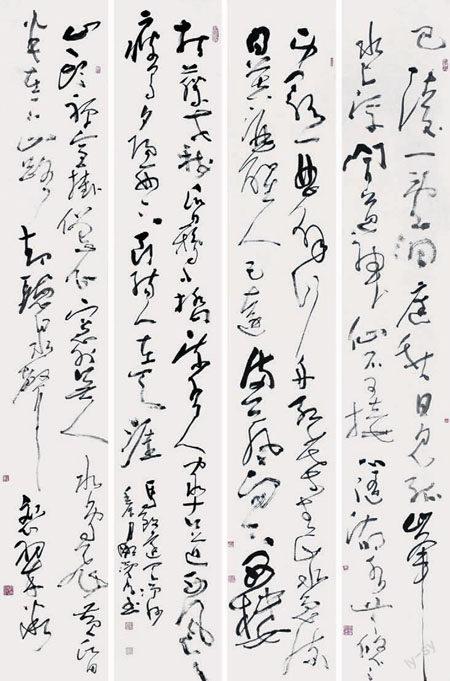Painter Yin Canghai:Never Forget the Journey’s Start
By HUA ZI


ON an old and gnarled pomegranate tree, heavy with red fruits, a mother bird feeds her nestlings. The scene that depicts autumn, harvest and parenthood is accomplished with a few subtle brushstrokes, revealing the painters deep understanding of the balance between realism and abstractionism.
The artist Yin Canghai, dressed in an unlined silk coat, walked toward me as if he had just stepped out of the painting. He spoke at length about connecting reality with art, and with the past.
The Road to Pursuing Art
Yin was born in 1966, in Anhui Provinces Xiaoxian County. The locality has produced a group of influential artists, such as painter Zhu Dequn, a lifetime fellow of Academy of Fine Arts of the Institute of France; Liu Kaiqu, recognized as the founder of modern Chinese sculpture; and Li Keran, a master of Chinese painting.
“Painting and calligraphy are highly regarded in Xiaoxian,” Yin said, adding that his becoming a painter was not unexpected. “From a young age, children are taught that painting is very elegant work.”
Yin became fascinated with the varied hues thatink produces on paper when mixed with water. He started studying painting and calligraphy at age four. Three years later, he became known as the“wonder child” and was invited to produce calligraphy at festive celebrations. By the time he was in middle school, he had copied all the illustrations that he could find at home and in school.
In 1986, Yin seized the first big opportunity of his life. He attended the Tianjin Academy of Fine Arts, majoring in Chinese painting. The four-year academic training provided him with a solid foundation of knowledge and skills, and at the same time expanded his worldview. Since this period coincided with the start of Chinas reform and opening-up, Yin became exposed to new artistic trends and different schools of thought, such as impressionism, abstraction, the existentialism of Sartre and Freudian psychonalysis.
But for a while after graduation, Yin felt unsure about his next step. He eventually decided to “return to tradition and seek internal support from the vast treasury of Chinese culture.” He spent years reading the classics and studying the art history of both the East and West, which helped sharpen his calligraphic and painting styles. This also made him more flexible and tolerant.
During an exhibition, Yin met distinguished painter Fan Zeng. Fan was so impressed with Yins pieces that he accepted the young painter as his first doctoral student. Under Fans guidance, Yin continued studying classical Chinese works and deepened his understanding of the humanities.
Master of Freehand Brushwork
“He is broad-minded and thinks little about fame or gain,” Fan once said of Yin. “What he is consumed with is ink and water and how to refine his skills. His works, as well as his character, are admired by fellow painters.”
Having dug deep into the artistic heritage of his home province, Yin became regarded as a creator of freehand brushwork, a distinct Chinese school of painting.
Yin has never hidden his ambition to excel in this art form. In his article “The Order of Art and Creation on Calligraphy and Painting,” he wrote that freehand brushwork manifests the Chinese artistic order. For thousands of years, Chinese calligraphers and painters have created a holistic concept of beauty and order, as well as relatively stable forms and rules of art. The established belief is that paintings should convey spiritual experience rather than mere forms, and illustrate what painters are thinking instead of just a scene.
Materials are also key to this construction of order: soft brushes, a wide spectrum of shades of ink, flowing water, and paper of good permeability. They make it possible for painters to present to their audiences the universe and their reflections on it. Every brushstroke and every ink dot represent a collision between the established artistic order and painters spiritual compulsions, and also show the process of constructing new orders.
Yin is expert at drawing figures, landscapes, flowers and birds. He never limits his themes and his works include contemporary people, myths and legends, and exotic locales. He also integrates Chinese virtues like gratitude, filial piety and harmony, which create sublime emotions that touch viewers.
Fellow painters especially recognize his contribution to Zen freehand brushwork. He demystified the relationship between flower-and-bird paintings and Zen freehand brushwork in his “The Influence of Zen Freehand Brushworks on Chinese Freehand Brushworks,” the first expanded discussion on the evolution of this relationship. Painting theorist Shao Dazhen said that Yin has found a way to combine the philosophic Zen with succinct freehand paintings and attain a state of freedom and purity.
Yins works bear the influence of ancient painters like Xu Wei, Zhu Da and Xu Gu, but he has channeled them into his own style. When interpreting Yins works, its not hard to figure out that the wild brushstrokes, lines and dots are his unique way of blending ink with water.
The Universal Realm
Audiences regard Yins paintings as elegant as
early spring in southern China and as fierce as the
autumn winds in the north. They can sense the pulse and enthusiasm beating beneath his brushstrokes. One of Yins most discussed pieces, measuring 3.1 by 2.46 meters, is Whom Are You Thinking about on This Chilly Windy Autumn Day, which hangs in the Great Hall of the Peoples Golden Hall. This is Yins second work to be acquired by the Great Hall – the first being Ten Miles of Lotus – which denotes high recognition of a Chinese artists work.
The process of creating Whom Are You Thinking about on This Chilly Windy Autumn Day has become a popular anecdote in art circles. While staging an exhibition in Shandong Province, Yin received a call from the Great Hall, asking if he could create a painting for an important upcoming conference. “Yes, of course,” Yin said. The problem was, he couldnt find a brush big enough for a large-scale painting.
While considering his options, he caught a glimpse of a new mop in a room corner and exclaimed, “Thats the brush!” Yin spread a gigantic sheet of paper on the floor, and set beside it two washbasins, one for water and another for ink. He dipped the mop into the basins and then started applying it on the blank paper. “I finished it in about an hour,” Yin recalled, “and it was shipped to Beijing immediately.”
This “carelessly created” painting was chosen from thousands of works. “The tool should always follow your heart,” Yin said. “Using a mop doesnt mean I was not serious.”
Modern Chinese philosopher Feng Youlan divided the spiritual state into four levels: the natural, utilitarian, moral and the universal realm. Yin said that he is now pursuing the universal realm. He said a person should know what he should do in his life– for himself, for society and something bigger and loftier.
“I need to feel calm in the depths of my heart. Only then can I feel the beauty of the immaterial and convey it through my brush.”
Chen Shouxiang, an expert on art history, once commented on Yins body of work: “Yins works have two basic characteristics. One is purity, and the other freedom – two things that people are seeking. Because of purity, the essence of his works can be easily sensed; because of freedom, the works can bring inspiration and enlightenment to their viewers.” Purity and freedom are the two most basic and the highest pursuits of painting in China.
Over the past 30 years since 1986, when Yin left his hometown, he witnessed dramatic changes in Chinese society, as well as one of the most important periods in modern Chinese painting. He has reflected on the importance of this time, and no matter how far away he journeys, he will never forget where and why he set off.

